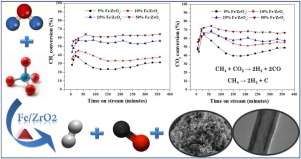当前位置:
X-MOL 学术
›
J. Ind. Eng. Chem.
›
论文详情
Our official English website, www.x-mol.net, welcomes your
feedback! (Note: you will need to create a separate account there.)
Production of hydrogen-rich syngas and multiwalled carbon nanotubes by biogas decomposition over zirconia supported iron catalysts
Journal of Industrial and Engineering Chemistry ( IF 5.9 ) Pub Date : 2020-04-01 , DOI: 10.1016/j.jiec.2019.12.030 Manoj Pudukudy , Zahira Yaakob , Khaleeda Mhd Syahri , Qingming Jia , Shaoyun Shan
Journal of Industrial and Engineering Chemistry ( IF 5.9 ) Pub Date : 2020-04-01 , DOI: 10.1016/j.jiec.2019.12.030 Manoj Pudukudy , Zahira Yaakob , Khaleeda Mhd Syahri , Qingming Jia , Shaoyun Shan

|
Abstract A set of Fe/ZrO2 catalysts were successfully synthesized by a facile urea-assisted solid-state combustion method, and their catalytic test was evaluated for the thermal decomposition of undiluted-biogas into hydrogen-rich syngas and multiwalled carbon nanotubes (MWCNTs). The as-prepared catalysts were characterized by X-Ray diffraction (XRD), Scanning and Transmission electron microscopy (SEM and TEM), Nitrogen-physisorption, X-ray photoelectron spectroscopy and Temperature programmed reduction analyses. The iron was found in the form of hematite and metallic-iron in the fresh and reduced catalysts respectively. A suitable metal-support interaction due to the fine surface dispersion of iron species on ZrO2 was observed in the catalysts. The N2-physisorption analysis indicated the reduced surface area of the catalysts after iron loading. However, it does not influence the catalytic efficiency since the metal amount and metal-support interaction was determined to play the main role. The Fe/ZrO2 catalysts exhibited improved catalytic efficiency. With increasing the amount of iron and increasing the reaction temperature, the CH4 and CO2 conversions were increased significantly. A highest CH4 and CO2 conversions of 92% and 89% respectively, with an H2/CO ratio of ∼2.25 were obtained for the 50%Fe/ZrO2 catalyst at 900 °C. The enhanced catalytic performance could be attributed to the fine-surface dispersion of iron-nanocrystals on ZrO2. Moreover, the MWCNTs were characterized by XRD, SEM, TEM and Raman analyses for their structural properties.
中文翻译:

在氧化锆负载的铁催化剂上通过沼气分解生产富氢合成气和多壁碳纳米管
摘要 通过简便的尿素辅助固态燃烧法成功合成了一组Fe/ZrO2催化剂,并对其催化试验对未稀释沼气热分解为富氢合成气和多壁碳纳米管(MWCNTs)进行了评价。所制备的催化剂通过 X 射线衍射 (XRD)、扫描和透射电子显微镜 (SEM 和 TEM)、氮物理吸附、X 射线光电子能谱和程序升温还原分析进行表征。铁分别以赤铁矿和金属铁的形式存在于新鲜和还原催化剂中。由于铁物质在 ZrO2 上的精细表面分散,在催化剂中观察到合适的金属-载体相互作用。N2 物理吸附分析表明催化剂在铁负载后表面积减少。然而,它不影响催化效率,因为金属量和金属-载体相互作用被确定起主要作用。Fe/ZrO2 催化剂表现出提高的催化效率。随着铁用量的增加和反应温度的升高,CH4和CO2的转化率显着增加。在 900 °C 下,50% Fe/ZrO2 催化剂的 CH4 和 CO2 转化率最高,分别为 92% 和 89%,H2/CO 比约为 2.25。增强的催化性能可归因于铁纳米晶体在 ZrO2 上的精细表面分散。此外,通过 XRD、SEM、TEM 和拉曼分析对 MWCNT 的结构特性进行了表征。Fe/ZrO2 催化剂表现出提高的催化效率。随着铁用量的增加和反应温度的升高,CH4和CO2的转化率显着增加。在 900 °C 下,50% Fe/ZrO2 催化剂的 CH4 和 CO2 转化率最高,分别为 92% 和 89%,H2/CO 比约为 2.25。增强的催化性能可归因于铁纳米晶体在 ZrO2 上的精细表面分散。此外,通过 XRD、SEM、TEM 和拉曼分析对 MWCNT 的结构特性进行了表征。Fe/ZrO2 催化剂表现出提高的催化效率。随着铁用量的增加和反应温度的升高,CH4和CO2的转化率显着增加。在 900 °C 下,50% Fe/ZrO2 催化剂的 CH4 和 CO2 转化率最高,分别为 92% 和 89%,H2/CO 比约为 2.25。增强的催化性能可归因于铁纳米晶体在 ZrO2 上的精细表面分散。此外,通过 XRD、SEM、TEM 和拉曼分析对 MWCNT 的结构特性进行了表征。50%Fe/ZrO2 催化剂在 900 °C 下获得了 25 个。增强的催化性能可归因于铁纳米晶体在 ZrO2 上的精细表面分散。此外,通过 XRD、SEM、TEM 和拉曼分析对 MWCNT 的结构特性进行了表征。50%Fe/ZrO2 催化剂在 900 °C 下获得了 25 个。增强的催化性能可归因于铁纳米晶体在 ZrO2 上的精细表面分散。此外,通过 XRD、SEM、TEM 和拉曼分析对 MWCNT 的结构特性进行了表征。
更新日期:2020-04-01
中文翻译:

在氧化锆负载的铁催化剂上通过沼气分解生产富氢合成气和多壁碳纳米管
摘要 通过简便的尿素辅助固态燃烧法成功合成了一组Fe/ZrO2催化剂,并对其催化试验对未稀释沼气热分解为富氢合成气和多壁碳纳米管(MWCNTs)进行了评价。所制备的催化剂通过 X 射线衍射 (XRD)、扫描和透射电子显微镜 (SEM 和 TEM)、氮物理吸附、X 射线光电子能谱和程序升温还原分析进行表征。铁分别以赤铁矿和金属铁的形式存在于新鲜和还原催化剂中。由于铁物质在 ZrO2 上的精细表面分散,在催化剂中观察到合适的金属-载体相互作用。N2 物理吸附分析表明催化剂在铁负载后表面积减少。然而,它不影响催化效率,因为金属量和金属-载体相互作用被确定起主要作用。Fe/ZrO2 催化剂表现出提高的催化效率。随着铁用量的增加和反应温度的升高,CH4和CO2的转化率显着增加。在 900 °C 下,50% Fe/ZrO2 催化剂的 CH4 和 CO2 转化率最高,分别为 92% 和 89%,H2/CO 比约为 2.25。增强的催化性能可归因于铁纳米晶体在 ZrO2 上的精细表面分散。此外,通过 XRD、SEM、TEM 和拉曼分析对 MWCNT 的结构特性进行了表征。Fe/ZrO2 催化剂表现出提高的催化效率。随着铁用量的增加和反应温度的升高,CH4和CO2的转化率显着增加。在 900 °C 下,50% Fe/ZrO2 催化剂的 CH4 和 CO2 转化率最高,分别为 92% 和 89%,H2/CO 比约为 2.25。增强的催化性能可归因于铁纳米晶体在 ZrO2 上的精细表面分散。此外,通过 XRD、SEM、TEM 和拉曼分析对 MWCNT 的结构特性进行了表征。Fe/ZrO2 催化剂表现出提高的催化效率。随着铁用量的增加和反应温度的升高,CH4和CO2的转化率显着增加。在 900 °C 下,50% Fe/ZrO2 催化剂的 CH4 和 CO2 转化率最高,分别为 92% 和 89%,H2/CO 比约为 2.25。增强的催化性能可归因于铁纳米晶体在 ZrO2 上的精细表面分散。此外,通过 XRD、SEM、TEM 和拉曼分析对 MWCNT 的结构特性进行了表征。50%Fe/ZrO2 催化剂在 900 °C 下获得了 25 个。增强的催化性能可归因于铁纳米晶体在 ZrO2 上的精细表面分散。此外,通过 XRD、SEM、TEM 和拉曼分析对 MWCNT 的结构特性进行了表征。50%Fe/ZrO2 催化剂在 900 °C 下获得了 25 个。增强的催化性能可归因于铁纳米晶体在 ZrO2 上的精细表面分散。此外,通过 XRD、SEM、TEM 和拉曼分析对 MWCNT 的结构特性进行了表征。











































 京公网安备 11010802027423号
京公网安备 11010802027423号